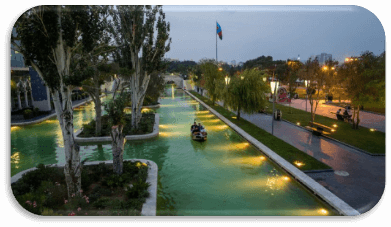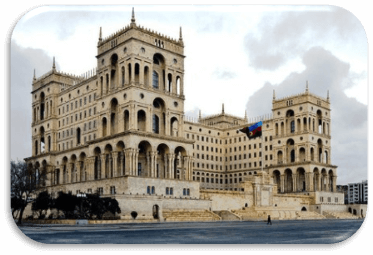-
Service 1: Tour Guide
-
Service 2: Transport
-
Service 3: Extra Transport to Mud volcanoes
-
Service 4: Boat Trip
-
Service 5: Funicular
-
Service 6: National Breakfast
-
Service 7: Lunch
-
Service 8: Dinner
-
Service 9: Museum
-
Service 10: Culinary Master class on cooking of Qutab
-
Service 11: Culinary Master Class on cooking of Dushbara
-
Service 12: Culinary Master class on cooking of Dolma
-
Service 13: Master class of Carpet weaving
-
Service 14: Art Master Class on drawing of Armudu glass
Description
Duration: 7-8 hours
9:00 Departure for excursion
State Flag Square (on the way)
One of the highest flags in the world flutters on the State Flag Square in Baku. The area covers an area of 60 hectares and its upper part is 31 thousand square meters.
Crystal Hall
In 2012, the sports hall Crystal Hall was built on the seaside boulevard, where international cultural events were held including the famous Eurovision Song Contest (2012).
Gobustan (Petroglyphs Museum)
 The museum of petroglyphs - called Gobustan - is a mountain town in the south-east of the Greater Caucasus Mountains, located 65 km from Baku. It was here that the ancient sites of primitive people were found, who left behind a lot of rock paintings - petroglyphs. These primitive monuments of art reflect the culture, economy, worldview, customs and traditions of ancient people. Long time ago the sea was splashing right at the foot of these mountains but then it retreated, leaving characteristic relief marks on the polished boiling rocks. After accidentally, in the 30s of the 20th century, unusual patterns were found on the rocks, their “openly” already more than 6 thousand (on 1000 rocks). Also found ancient primitive dwellings - caves and parking, more than 100 thousand items of material culture. Gobustan petroglyphs belong to different epochs. They were made in the period from X - XVIII thousand BC until the middle ages of our epoch.
The museum of petroglyphs - called Gobustan - is a mountain town in the south-east of the Greater Caucasus Mountains, located 65 km from Baku. It was here that the ancient sites of primitive people were found, who left behind a lot of rock paintings - petroglyphs. These primitive monuments of art reflect the culture, economy, worldview, customs and traditions of ancient people. Long time ago the sea was splashing right at the foot of these mountains but then it retreated, leaving characteristic relief marks on the polished boiling rocks. After accidentally, in the 30s of the 20th century, unusual patterns were found on the rocks, their “openly” already more than 6 thousand (on 1000 rocks). Also found ancient primitive dwellings - caves and parking, more than 100 thousand items of material culture. Gobustan petroglyphs belong to different epochs. They were made in the period from X - XVIII thousand BC until the middle ages of our epoch.
Mud Volcanoes (on request)
Gobustan is also known for its mud volcanoes which can be counted in the hundreds. By the number of mud  volcanoes Azerbaijan ranks first in the world. There are 350 of them (about 800 in the world). Most volcanoes are low mud geysers including those below adult height. Mud volcanoes are active all year round. They themselves are associated with oil and gas fields, so their soil is saturated with oil. With minor or even large eruptions, dirt, like lava, begins to flow freely from the crater and then dries on the walls outside. And the largest mud volcano in Gobustan reserve is Kianizadag.
volcanoes Azerbaijan ranks first in the world. There are 350 of them (about 800 in the world). Most volcanoes are low mud geysers including those below adult height. Mud volcanoes are active all year round. They themselves are associated with oil and gas fields, so their soil is saturated with oil. With minor or even large eruptions, dirt, like lava, begins to flow freely from the crater and then dries on the walls outside. And the largest mud volcano in Gobustan reserve is Kianizadag.
Bibi-Heybat Mosque (on the way)
 This mosque is located on the shore of the Baku Bay, in the village of Shikhovo in Azerbaijan. The existing building was erected in 1998–1999 on the site of a mosque of the same name, built in the second half of the 13th century by Shirvanshah Abdul-Fath-Farrukhzad, subsequently repeatedly completed (last time in 1911).
This mosque is located on the shore of the Baku Bay, in the village of Shikhovo in Azerbaijan. The existing building was erected in 1998–1999 on the site of a mosque of the same name, built in the second half of the 13th century by Shirvanshah Abdul-Fath-Farrukhzad, subsequently repeatedly completed (last time in 1911).
14:00 - 15:00 Lunch break (Master class on request)
“Nush Olsun!” - “Bon appetit!”, They will tell you in every corner of Azerbaijan, cordially inviting you to an abundant feast. The most sophisticated gourmets who come to the republic will like the refinement and delicate aroma of Azerbaijani  dishes. The history of the art of culinary recipes in Azerbaijan goes back centuries and is based on the vast experience of hereditary chefs that is preserved today. In terms of the composition and multiplicity of dishes, Azerbaijani cuisine is among the extremely diverse and healthy and is distinguished by an abundance of all sorts of meat, fish and vegetable delicacies, complemented by tender greens and savory spices. The dishes in tandoor are widely spread in the Azerbaijani cuisine. Trere are a large assortment of various sweets and drinks. Exclusive Azerbaijani dishes - dolma, bozbash, bozartma, chyhyrtma, khashil, kebab, piti, pilaf, govurma - are included in the national menu of many peoples of the Caucasus.
dishes. The history of the art of culinary recipes in Azerbaijan goes back centuries and is based on the vast experience of hereditary chefs that is preserved today. In terms of the composition and multiplicity of dishes, Azerbaijani cuisine is among the extremely diverse and healthy and is distinguished by an abundance of all sorts of meat, fish and vegetable delicacies, complemented by tender greens and savory spices. The dishes in tandoor are widely spread in the Azerbaijani cuisine. Trere are a large assortment of various sweets and drinks. Exclusive Azerbaijani dishes - dolma, bozbash, bozartma, chyhyrtma, khashil, kebab, piti, pilaf, govurma - are included in the national menu of many peoples of the Caucasus.
14:30 Walking around the city of Baku
The Garden of Ali Agha Vahid (Governor’s Garden 1830)
Ali Agha Vahid Garden, formerly known as the Mikhailovsky or Governor’s Garden, is one of the oldest parks in the capital of Azerbaijan, in the city of Baku. The governor’s Sadik, also known as Mikhailovsky, also known as the Garden of the Revolution, is in fact the oldest garden in the city and for a very long time remained the only garden in Baku. One of the oldest and busiest gardens in the city is Mikhailovsky, or as residents often called him, the Governor’s (4.6 hectares), went through a long stage of formation, until the final planning structure was formed, which successfully fit into the relief.
 Baku Seaside Boulevard (1909)
Baku Seaside Boulevard (1909)
Baku Seaside Boulevard (1909) is one of the attractions of Baku, a favorite resting place of Baku residents and city guests. In 2009 it celebrated its 100th anniversary. The length of the park before the reconstruction was 16 kilometers and after the general reconstruction is 25 km.
Little Venice (1960)
In 1960 at the very edge of Baku Boulevard city authorities built an amazing complex of canals and islands. Little Venice is a landmark of the seaside park and is considered a favorite resting place for visitors to the park.
Museum of Azerbaijani Carpet (1967)

The Azerbaijan Carpet Museum was founded in 1967 becoming the first specialized museum in the world to collect, preserve and study carpet. The museum is a treasure trove of Azerbaijani national culture, showing the carpet in close relationship with other types of traditional art of Azerbaijan.
Fountain Square
Fountain Square is one of the main attractions of the Azerbaijani capital. The square has been the cultural center of Baku since the 1860s, surrounded by important historical buildings:one of the country's first cinema halls - Araz (1870); Old Grand Hotel; Nizami Museum, operating since the end of the XIX century.
Highland Park (Kirov Park- 1934)

The park is viewed from almost any point of Boulevard but climbing up opens the best view of the city. The mountainous park is worth a visit at different times of the day - in the morning to meet the sunrise, in the afternoon to see the main sights of Baku from a bird's eye view and in the evening you can take a long look at illumination of night Baku and enjoy the laser show Flame Towers.
The best way to get to the Highland Park is by the funicular - such a rare type of urban transport, by the way, the Baku funicular is also a separate attraction in itself.
'
Flame Towers (2007)
Flame Towers - the highest buildings in Azerbaijan located in Baku. Its appearance of the tower resemble three flames.
Government House of Azerbaijan- 1936- 1952 (passing through)
The Government House of Azerbaijan is a magnificent palace-type building. in the Baroque style It was built by architects L.V. Rudnev and V.O. Munzem in the Baroque style .The prototype for the three rows of columns on each side of the building was the colonnade of the reception hall of the Shirvanshahs Palace. Today the Government House is considered one of the main attractions of the city of Baku.
 Heydar Aliyev Center (2007)
Heydar Aliyev Center (2007)
Heydar Aliyev Center - a project that was designed by renowned architect Zaha Hadid, is one of the most famous cultural centers of the capital of Azerbaijan.
17:00 End of the tour

